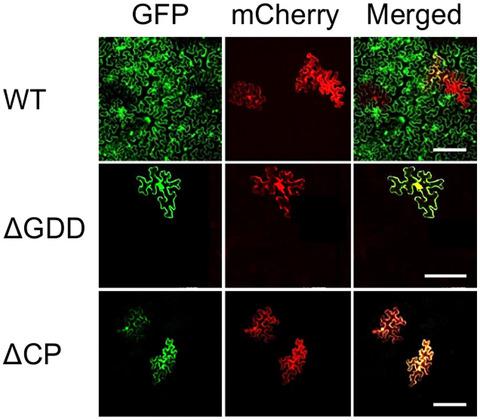当前位置:
X-MOL 学术
›
Mol. Plant Pathol.
›
论文详情
Our official English website, www.x-mol.net, welcomes your feedback! (Note: you will need to create a separate account there.)
The cis-expression of the coat protein of turnip mosaic virus is essential for viral intercellular movement in plants.
Molecular Plant Pathology ( IF 4.9 ) Pub Date : 2020-07-19 , DOI: 10.1111/mpp.12973 Zhaoji Dai 1, 2 , Rongrong He 1, 2 , Mark A Bernards 2 , Aiming Wang 1
Molecular Plant Pathology ( IF 4.9 ) Pub Date : 2020-07-19 , DOI: 10.1111/mpp.12973 Zhaoji Dai 1, 2 , Rongrong He 1, 2 , Mark A Bernards 2 , Aiming Wang 1
Affiliation

|
To establish infection, plant viruses are evolutionarily empowered with the ability to spread intercellularly. Potyviruses represent the largest group of known plant‐infecting RNA viruses, including many agriculturally important viruses. To better understand intercellular movement of potyviruses, we used turnip mosaic virus (TuMV) as a model and constructed a double‐fluorescent (green and mCherry) protein‐tagged TuMV infectious clone, which allows distinct observation of primary and secondary infected cells. We conducted a series of deletion and mutation analyses to characterize the role of TuMV coat protein (CP) in viral intercellular movement. TuMV CP has 288 amino acids and is composed of three domains: the N‐terminus (amino acids 1–97), the core (amino acids 98–245), and the C‐terminus (amino acids 246–288). We found that deletion of CP or its segments amino acids 51–199, amino acids 200–283, or amino acids 265–274 abolished the ability of TuMV to spread intercellularly but did not affect virus replication. Interestingly, deletion of amino acids 6–50 in the N‐terminus domain resulted in the formation of aberrant virions but did not significantly compromise TuMV cell‐to‐cell and systemic movement. We identified the charged residues R178 and D222 within the core domain that are essential for virion formation and TuMV local and systemic transport in plants. Moreover, we found that trans‐expression of the wild‐type CP either by TuMV or through genetic transformation‐based stable expression could not rescue the movement defect of CP mutants. Taken together these results suggest that TuMV CP is not essential for viral genome replication but is indispensable for viral intercellular transport where only the cis‐expressed CP is functional.
中文翻译:

芜菁花叶病毒外壳蛋白的顺式表达对于植物中病毒的细胞间运动至关重要。
为了建立感染,植物病毒在进化上具有在细胞间传播的能力。猪病毒代表已知的最大的植物感染RNA病毒,包括许多农业重要病毒。为了更好地了解杯状病毒的细胞间运动,我们使用了芜菁花叶病毒(TuMV)作为模型,并构建了一个带有双荧光(绿色和mCherry)蛋白标签的TuMV感染性克隆,从而可以分别观察原发和继发感染细胞。我们进行了一系列的删除和突变分析,以表征TuMV外壳蛋白(CP)在病毒细胞间运动中的作用。TuMV CP具有288个氨基酸,由三个结构域组成:N端(氨基酸1–97),核心(氨基酸98–245)和C端(氨基酸246–288)。我们发现,删除CP或其片段的51-199位氨基酸,200-283位氨基酸或265-274位氨基酸可以消除TuMV在细胞内扩散的能力,但不会影响病毒的复制。有趣的是,N末端结构域第6至50位氨基酸的缺失导致异常病毒粒子的形成,但并未显着损害TuMV的细胞间和全身运动。我们在核心域中确定了带电残基R178和D222,这些残基对于病毒体形成以及TuMV在植物中的局部和全身运输至关重要。此外,我们发现 N末端结构域6-50氨基酸的缺失导致异常病毒粒子的形成,但并未显着损害TuMV的细胞间和全身运动。我们在核心域中确定了带电残基R178和D222,这些残基对于病毒体形成以及TuMV在植物中的局部和全身运输至关重要。此外,我们发现 N末端结构域6-50氨基酸的缺失导致异常病毒粒子的形成,但并未显着损害TuMV的细胞间和全身运动。我们在核心域中确定了带电残基R178和D222,这些残基对于病毒体形成以及TuMV在植物中的局部和全身运输至关重要。此外,我们发现TuMV或通过基于遗传转化的稳定表达对野生型CP的反式表达不能挽救CP突变体的运动缺陷。综上所述,这些结果表明TuMV CP对于病毒基因组复制不是必需的,但对于仅顺式表达CP起作用的病毒细胞间运输是必不可少的。
更新日期:2020-07-19
中文翻译:

芜菁花叶病毒外壳蛋白的顺式表达对于植物中病毒的细胞间运动至关重要。
为了建立感染,植物病毒在进化上具有在细胞间传播的能力。猪病毒代表已知的最大的植物感染RNA病毒,包括许多农业重要病毒。为了更好地了解杯状病毒的细胞间运动,我们使用了芜菁花叶病毒(TuMV)作为模型,并构建了一个带有双荧光(绿色和mCherry)蛋白标签的TuMV感染性克隆,从而可以分别观察原发和继发感染细胞。我们进行了一系列的删除和突变分析,以表征TuMV外壳蛋白(CP)在病毒细胞间运动中的作用。TuMV CP具有288个氨基酸,由三个结构域组成:N端(氨基酸1–97),核心(氨基酸98–245)和C端(氨基酸246–288)。我们发现,删除CP或其片段的51-199位氨基酸,200-283位氨基酸或265-274位氨基酸可以消除TuMV在细胞内扩散的能力,但不会影响病毒的复制。有趣的是,N末端结构域第6至50位氨基酸的缺失导致异常病毒粒子的形成,但并未显着损害TuMV的细胞间和全身运动。我们在核心域中确定了带电残基R178和D222,这些残基对于病毒体形成以及TuMV在植物中的局部和全身运输至关重要。此外,我们发现 N末端结构域6-50氨基酸的缺失导致异常病毒粒子的形成,但并未显着损害TuMV的细胞间和全身运动。我们在核心域中确定了带电残基R178和D222,这些残基对于病毒体形成以及TuMV在植物中的局部和全身运输至关重要。此外,我们发现 N末端结构域6-50氨基酸的缺失导致异常病毒粒子的形成,但并未显着损害TuMV的细胞间和全身运动。我们在核心域中确定了带电残基R178和D222,这些残基对于病毒体形成以及TuMV在植物中的局部和全身运输至关重要。此外,我们发现TuMV或通过基于遗传转化的稳定表达对野生型CP的反式表达不能挽救CP突变体的运动缺陷。综上所述,这些结果表明TuMV CP对于病毒基因组复制不是必需的,但对于仅顺式表达CP起作用的病毒细胞间运输是必不可少的。


























 京公网安备 11010802027423号
京公网安备 11010802027423号